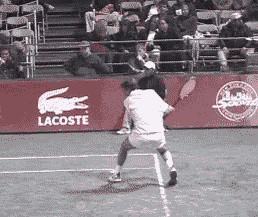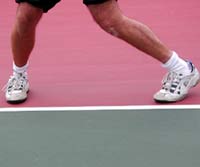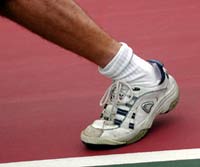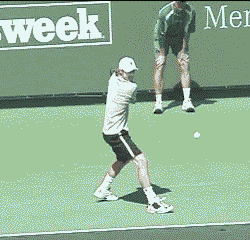|
TennisOne Lessons The Circle of Powerby Corky Cramer
For years when a player would ask me for help with a specific stroke I would take what seemed the most logical approach, start at the beginning and proceed to the end - watch the ball, step in, follow through, etc. It all seemed simple enough yet there was something that always bothered me about that approach. By compartmentalizing as such, was I really teaching my students what playing the game is really all about? What is the beginning and what is the end? That is the question I kept asking my self, because tennis isn't really linear, it's more like a circle with each part interrelated and heavily dependent on that which comes before and after. Interrupt the biomechanical, kinetic circle and the entire sequence breaks down and with it, the power and rhythm of the stroke. Why the Recovery Step?Often when rallying or working with my students one will ask, "How come I'm running around like a chicken and your just standing still all the time?" or "I don't want to but it seems like I keep hitting the ball right to you."
The answer is easy, very often, after hitting a stroke we often fail to finish properly and get into position to play the next ball. I believe a stroke is not completed until the player has taken at least one step towards the position where they want to receive the opponent's next ball. This is usually referred to as the recovery step but I believe it is actually a vital part of the shot just completed and should be treated as such. Tennis is a game of nearly constant motion and when viewing great groundstrokers, one of the elements that stand out is how quick pro players are to the ball. The common factor of speed and balance is one that cannot be denied and is a prerequisite to developing a solid baseline game. Proper recovery insures maximized body rotation and that translates not only into quickness but also POWER. Quickness because it replaces the two or three steps that bring the body to a gradual stop and it enables you get to the next place on the court much quicker and thus hit the next ball with an offensive frame of mind. And power because it is the maximized rotation of the body that allows for a more explosive and effortless drive into the ball. Lets examine each of these issues a little closer using a right-handed backhand as an example. C onserving EnergyWhen the classic recovery step is executed, the following elements will have transpired prior to the step. The left leg has been used to make an adjustment step and establish itself as an anchor. This stable position enables the left foot to push off the ground launching the body forward with the weight transferring to the front leg. This weight shift allows for an explosive drive up and into the ball.
I cringe when a player tells me their coach told them to hold the position with their weight down on their front foot and keep their bodies perpendicular to the net with just the racquet extending away. This makes it difficult to maintain balance and drive the ball with any pace. The sudden stops tend to have a jarring effect on the knees. It also places considerable stress on the quadricep and increases greatly the possibility of falling or turning an ankle. Here the recovery step comes into play. With the left leg muscles in a relaxed state allow the leg to swing around. As the foot touches down the leg and knee will act like a shock absorber loading up and serving as a breaking mechanism, prevent excessive lateral movement on the court thereby reducing the number of steps taken. Often overlooked is the angle of the left foot when it touches down. The foot should be turned inward creating a pigeon toed stance. This decreases the chances of rolling over on the ankle (considered one of the top three tennis injuries) and simultaneously creates the fastest starting position to move to your right.
Note; the greater you allow the knee to bend and absorb the landing, the faster you will be able to accelerate back toward your right. But the real concern here is the ball contact element of the stroke and this detailed footwork allows for the body's complete rotation into the ball, providing tremendous acceleration and power. At the same time racquet hand is free to assume it's primary responsibility, the feel of the ball. The same footwork applies to the two handed backhand which is exemplified by the slight, yet lightening fast and hard-hitting Lleyton Hewitt. The Recovery Step as a StrategistWhen you create a forceful rotation of the body and allow the rear leg to come around, it will automatically point you in the right direction to prepare for the next shot. When moving to your left, the recovery step will bounce you back to the right. When taking a ball on the rise and moving forward the recovery step will be headed straight ahead toward the net. Let you feet lead the way to orchestrating a winning a point.
As one of the top coaches in Canadian history, he developed over 50 players who won national titles, and coached over a dozen Davis Cup and Fed Cup players. A 25 year USPTA member, Corky is also a board member for The Advanced Tennis Research Project ( www.AdvancedTennis.com ). |
||||||||






 Corky Cramer, TennisONE contributing editor, is beginning a new series of articles from America's Great Teaching Pros. He is the Director of Tennis at the Montecito Heights Health and Racquet Club in Santa Rosa, California.
Corky Cramer, TennisONE contributing editor, is beginning a new series of articles from America's Great Teaching Pros. He is the Director of Tennis at the Montecito Heights Health and Racquet Club in Santa Rosa, California.